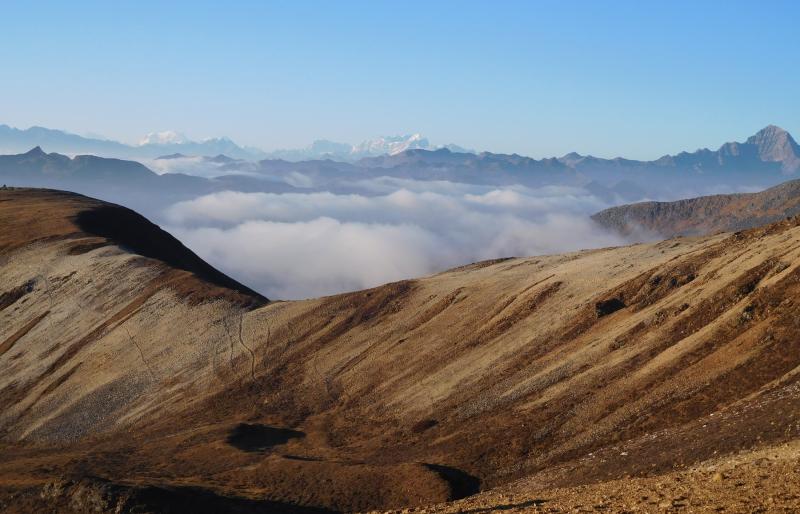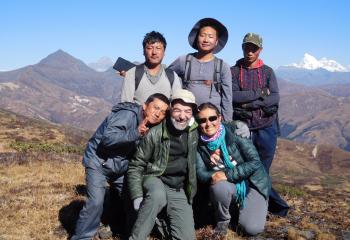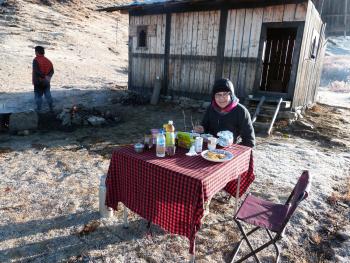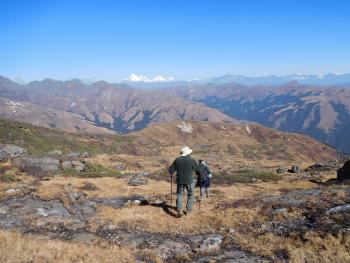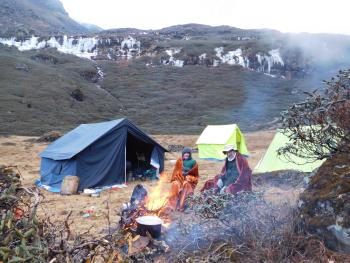A challenging trek in the mountains of Bhutan rewards with rarely seen vistas
This article appears on page 20 of the July 2018 issue.
Bhutan has become a “go to” destination since the country opened to outside travelers in 1974. That first year, just 287 visitors were permitted entry, but tourism has exploded recently, from 23,480 visitors in 2009 to 254,704 foreign individuals visiting Bhutan in 2017.
‘So what’s the attraction?’ you might ask. Bhutan is an amazing destination with much to offer.
This tiny kingdom (population 797,765) limits visas and makes sure we visitors are taxed for our impact on their environment. The country has made a concerted effort to not exploit their natural resources for short-term gain.
The cultural attractions include their unique architecture, national dress, traditional sports and Buddhist beliefs, and, of course, there’s the country’s natural beauty. All this has been well documented in recent ITN articles (for example, April ’17, pg. 46, and Oct. ’17, pg. 18). But this country is not overrated. (Please, visit!)
My wife, Lois, and I did enjoy Bhutan’s culture, but this article is about a walk in the well-protected outback, following an entirely new path to rarely seen vistas.
Preparing for a challenge
In researching our trips, I rely on Lonely Planet’s Thorn Tree blog (www.lonelyplanet.com/thorntree/welcome), where travelers like us can candidly exchange opinions and advice online.
Coincidentally, a recent poll of the blog’s readers recommended four Bhutan tour agencies to consider. I accessed each and appreciated a prompt, thorough response from Blue Poppy Tours & Treks (offices in London and Thimphu; www.blue poppybhutan.com).
After reading about a new route the company was offering, Tergo La Trek, I was fascinated by the opportunity to trek in a pristine region of the Himalayas only recently opened to travelers. Starting near Haa, the 8-dayjourney was listed as “challenging” and is offered only from April to mid-November.
My first Himalayan trek, in 1979, was in the Ladakh part of Kashmir in northwestern India, where I suffered from a dozen symptoms of Acute Mountain Sickness (AMS). In 2004, I needed oxygen while traversingsome passes in Tibet. Although I again suffered from AMS while summiting Kilimanjaro in 2007, it was a cakewalk compared to these eight days going up and down at altitudes between 12,000 and 14,000 feet.
I did not experience AMS nausea or headaches on this 2017 trip, only tolerable insomnia, lack of appetite and chronic shortness of breath. Lois is, fortunately, immune to AMS.
I should offer a caveat right up front: this is not your grandchild’s hike. On a challenge scale of 1 to 5, this rates a 6. I had visions of the well-worn paths I’d traversed on Kilimanjaro, but no such paths were to be found. Level ground may have constituted 10% of our route, but it was often on narrow paths that crossed recent landslides where you really didn’t want to look down.
Lois and I are septuagenarians who leave sweat on the gym floor daily. Decades of lunges and squats paid off; we never experienced the slightest muscle pain or blister the entire trek. There were many opportunities for spraining ankles as well as for fatal falls, but our fitness prevented tragedy.
Trip evacuation insurance would have been useless, as even helicopters can’t fly in the thin air there, and the nearest comprehensive medical care available is in Bangkok, a 4-hour flight from Paro.
With that said, the professionalism of our Blue Poppy crew assuaged my “Whoops!” moment on the second day of the trek, when the importance of making every step work came home.
On a couple of frightful crossings, the path was a size 9 and I was wearing size 13 boots. My wife easily made it across, but I needed the iron grip of our guide along with her calm demeanor and steadiness.
Enough of the “cheery” reasons why we chose to put our lives in danger! Let’s move on to the rewards.
Getting there
We wired Blue Poppy the all-inclusive cost of $9,100 for two (including $1,650 for the Bangkok-Paro flight) for our Nov. 19-Dec. 1 “Tergo La and Culture Tour of Paro and Thimphu.”
Bangkok was an appropriate hub for our planned month-long Bhutan/Laos vacation, and I was really lucky to score two Kansas City-Chicago-Tokyo-Bangkok round-trip flights on All Nippon Airways for an amazing$1,695 on www.justfly.com. All flights were on time, and the service was delightful.
From Bangkok, we flew into Paro, Bhutan, where, at 2,200 meters (7,218 feet), the only space flat enough for Bhutan’s one international airport is located. Landing was an experience in itself.
We were met by our intrepid guide, Chhimi Dema, a 33-year-old single mother who spoke excellent British English and was perfect in every way. She candidly responded to even personal questions about Bhutanese life. Most importantly, she said what every traveler wants to hear from their guide: “I love my job.”
Paro
Our accommodation at Hotel Gangtey Palace (phone +975 8 271301, www.gangteypalace.com), a former governor’s palace, was in the charming servants’ quarters. At dinner, we found Bhutanese cuisine to be less spicy than we anticipated. Fitting our personal preference, there was a variety of vegetarian choices with rice.
We took our first acclimation climb to the famous Tiger’s Nest (Paro Taktsang) the next day. Built in 1692 around the cave where founder Guru Rinpoche allegedly meditated for three years, three months, three days and three hours, it sits at an elevation of 10,240 feet. The climb in perfect weather was easy for us, and the monastery visit was delightful.
A day later, after a half-hour drive from Paro, we arrived at Chele La Pass (11,500 feet) and hiked from 9:30 a.m. to 1:30 p.m. through a forest of prayer flags before enjoying an excellent picnic lunch.
After a 2½-hour drive to Haa, we settled into Soednam Zingkha Heritage Lodge (www.szingkha.com), a farmhouse/guest house where we spent our last night sleeping in a bed on this trip. For the coming days, we repacked our gear, as only one bag weighing about 10 kilograms was allowed on the horse that would transport our bag.
On the trail
On the morning of Nov. 22, a 2½-hour drive took us to the end of a road under construction, the starting point of our trek.
Our Blue Poppy crew consisted of our guide, Chhimi; Kinley, our driver; Damcho, the cook, and GoGo, the assistant cook; Dawa, a big horseman, and Nima, a shy horseman, and seven (unnamed) horses.
We loaded up everything we would need for the next eight days — fresh food, tools, propane, tents and all necessary trekking gear — and carried out all rubbish. (As an example of how strict the regulation about trash is, at one point I threw a used juice box into the campfire and it was “rescued” by one of our team as an inappropriate leave-behind. “Take only pictures. Leave only footprints.”)
As we started off, I realized that we would not see any evidence of humans (other than stone yak-herder summer huts). Our first day on the trail was very challenging, with overcast skies, a nasty windstorm and a rockytrail most of the way. We were thankful to reach camp at around 4:30 p.m., and after dinner we crashed in our tent.
A typical day
We usually woke around 7 to 8 a.m., and our crew would bring a pan of hot water for us to wash with. This was followed by coffee/tea and a hot breakfast (eggs, porridge, fruit, toast, condiments, etc.), served either in the dining tent or outside near the fire, depending on the weather.
After breakfast, we would pack our personal items in our tent before starting the day’s trek with our guide and the assistant cook, who carried our hot lunch. The crew would strike the camp and pack up the horses that would later pass us on the trail.
The trail is based on routes herders use twice a year to take their yaks up for summer forage and are, therefore, very narrow and rugged. Our campsites were located where water and firewood was available.
When we arrived at a new campsite, our tent, the toilet tent and the cook’s tent would already be set up. As soon as the crew arrived, the cook would begin to prepare our evening meal from the fresh food carried in, as nothing we ate was processed or dehydrated.
After securing the horses, the two horsemen would gather water and firewood, and there would be a bonfire, hot tea and coffee and a kettle of boiling water each evening. After dinner, we usually retired to our (sigh!) cold tents, hugging welcomed hot-water bottles.
About our gear
Every piece of equipment we took with us exceeded performance expectations, especially our hiking boots. We chose to not take our inadequate 3-season sleeping bags, instead renting Blue Poppy year-rounds that were just adequate. (It was REALLY that cold!) The supplied two-inch-thick foam plus our own inflatable sleeping pads kept us off the cold ground.
The tents were fine, but nights were cold enough for frost to form on the ceiling, which was an annoyance. Overnight, our water bottles froze, and our sleeping bags got frosted as well.
We slept fully clothed, except for changing from day clothes into sweatpants at night. On top, Lois wore seven layers — silk underwear; undershirt; long sleeved cotton shirt; button-down shirt; quilted jacket; quilted hooded jacket; Polartec jacket — and, on her head, ear warmers, a Polartec hat and hoods from both jackets. She also wore two sets of long silk underwear under her pants.
We each wore only one pair of socks, but a hot-water bottle at our feet inside our sleeping bags at night was very welcomed.
For most of our days on the trail, we were fortunate enough to enjoy stunning views of the mountains, which are not always visible. This was brought to our attention by our Bhutanese crew, some of whom had traversed this trail before but had never seen these vistas due to poor visibility. At several points, they scrambled to take cell phone pictures.
On our last night on the trail, we camped at Womgithang (12,670 feet), where it snowed; we awoke to a beautiful white landscape. However, this created a hiking challenge, as the sun melted the snow where it shone while the rest of the trail remained icy.
Fortunately, our final day was mostly downhill on relatively smooth paths.
Our trek coming to a close, we met our driver for the ride back to Haa and a rest at Ugyen Homestay (haavalleyhomestay.com/ugyens-house), where we ordered a much-appreciated dotsho, or hot-stone bath with herbs, for two.
The take-away?
Bhutan has much to offer, without many of the common developing-country negatives. If you can afford the costly fees ($250 per person per day plus some add-ons) and are comfortable with their proscriptions, you will be rewarded with all that is promised and more.
If you wish to enjoy the unbelievable, hardly-ever-seen vistas we experienced, be forewarned: this trek is not for the fainthearted. My main suggestion to Blue Poppy was to require applicants, especially seniors, to provide certification from their physicians about their ability to complete this challenging trek.
By the third day I was asking, “What were we thinking?” However, we were subsequently very pleased by our ability to prevail and experience such an extraordinary adventure.
Our final two days consisted of the typical cultural tour of Thimphu, the capital, memorable for an ironic happening. After all that dangerous trekking, I slipped and fell hard on my left knee while climbing stairs to a restaurant for lunch, fracturing the patella. I had a serious limp for our remaining time in Bhutan.

